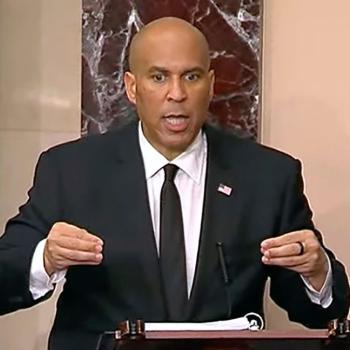Ezekiel’s sermon to the dry bones echoes across the millennia to our own time and our need for racial restoration and reparations.

The reflection below is one I wrote for “Jesus and Justice in Public,” a study-action guide by the Wisconsin Council of Churches. They developed this guide to help the Church respond to the rising threats of White Christian Nationalism that have become increasingly violent and include attacks on our democracy. The guide offers hands-on ways that the Church has historically engaged in civic life and what these practices can look like in our modern context.
I was invited to write a series of homiletical helps so that preachers can connect these lessons to the readings in Lent from the Revised Common Lectionary for Year A. This reflection is for the Fifth Sunday of Lent and focuses on Ezekiel 37:1-14, the story God restoring the “dry bones” of Israel. However, these essays can be used at any time of the year.
Ezekiel 37:8-10
As I prophesied, suddenly there was a noise, a rattling, and the bones came together, bone to its bone. 8I looked, and there were sinews on them, and flesh had come upon them, and skin had covered them; but there was no breath in them. 9Then he said to me, ‘Prophesy to the breath, prophesy, mortal, and say to the breath: Thus says the Lord God: Come from the four winds, O breath, and breathe upon these slain, that they may live.’ 10I prophesied as he commanded me, and the breath came into them, and they lived, and stood on their feet, a vast multitude.
“Dem Bones”
Many people are familiar with the song, “Dem Bones.”
“The toe bone’s connected to the foot bone. The foot bone’s connected to the leg bone,” and so on, culminating in the call for all the bones to “hear the word of the Lord.”
What some may not realize is that the song was inspired by Ezekiel’s prophetic vision of desiccated bones miraculously coming together to reconstitute the nation of Israel. And the person who wrote the song was James Weldon Johnson (1871-1938). Together with his brother, J. Rosamond Johnson, they composed the music and lyrics in 1928.
Who was James Weldon Johnson? He was a civil rights activist who also wrote the hymn that became the anthem of the Civil Rights Movement: “Lift Every Voice and Sing.”

Preaching resurrection to the dead
A sermon about this song, this songwriter, and this passage from Ezekiel would be one way to bring a sermon series countering Christian Nationalism to its penultimate point on the Fifth Sunday of Lent. This is because the new life for dry bones that God showed Ezekiel in the midst of that valley of death resonates with the way that African American slaves and their descendants envisioned and embodied resurrection.
As described by Brian Blount in Invasion of the Dead: Preaching Resurrection, slaves “represent the living dead, humans owned by other humans, humans declared by constitutional mandate to be only three-fifths of other humans, humans segregated and cordoned off from polite society because they were regarded as subhuman in some important ways” (29). Yet, like Ezekiel seeing a future for his people beyond exile, African Americans “glimpsed what resurrection beyond slavery looked like, what resurrection beyond segregation looked like, and then embodied it and preached it” (29).
Countering the white supremacy of Christian Nationalism
Christian Nationalism today takes aim at any attempts of reconstituting the memory, history, and people who suffered and died under slavery and its aftermath. These efforts show up many ways, such as school boards forbidding the teaching of “critical race theory.” And efforts to overturn affirmative action. Not to mention white supremacy groups publicly and boldly declaring their agenda to “take America back” for whites. These are just some of the ways that the sin of racism continues to infect the soul of America.
The church’s problem of white racial purity
However, it’s important to note that the White supremacy of Christian Nationalism is not restricted to virulent hate groups or Evangelical extremists. As Robert Jones has documented in his book, White Too Long: The Legacy of White Supremacy in American Christianity, the ideology of white racial purity has been embedded within American Christianity since its founding.
The church provided the theological rationale both for brutally colonizing the indigenous peoples of the Americas and for kidnapping and enslaving millions of Africans. Mainline denominations upheld the structures of the country’s racialized caste system for hundreds of years. Today, even sermons about antiracism are taboo in many white churches. This results in a code of silence protecting what Jones calls “an unassailable sense of religious purity that protects white racial innocence,” (20-21).
How can we help reconnect “dem bones”?
One way that churches might help to “connect the bones” and reconstitute the Black community is by advocating for voting rights. Another is to call for the end of gerrymandering, which literally disconnects Black neighborhoods from the body politic.
Churches can also support reparation efforts such as the kind being undertaken in the state of California and the city of San Francisco.
Ezekiel’s sermon to the dry bones echoes across the millennia to our own time and our need for restoration and reparations. God is already doing this work; in what ways will we stand along Ezekiel and prophesy?
Central Question, Central Claim, Central Purpose
(The Central Question, Central Claim, and Central Purpose statements are a way to organize and provide direction for a sermon. I developed this process in the book Introduction to Preaching: Scripture, Theology, and Sermon Preparation (Rowman & Littlefield, 2013). Here are possible Central Statements for a sermon based on Ezekiel 37:1-14 countering the white supremacy of Christian Nationalism.)
Central Question. How can the church help to “reconnect the bones” and reconstitute the Black community, just as Ezekiel prophesied to the valley of bones?
Central Claim. Ezekiel’s sermon to the dry bones echoes across the millennia to our own time and our need for racial restoration and reparations.
Central Purpose. This sermon urges the congregation to take concrete actions for racial justice, such as advocating for voting rights and calling for the end of gerrymandering so that Black neighborhoods can be rejoined to the body politic and exercise their own power and agency.
To see the full series of sermon helps, download “Jesus and Justice” here.
Read also:
The Parable of the Talents Through the Lens of Race, Privilege & Wealth
6 Bible Texts for a Sermon on Racism & Why Your Church Needs to Hear It
What Toni Morrison Taught Me About Racism in Her Book ‘Beloved’
The Rev. Dr. Leah D. Schade is the Associate Professor of Preaching and Worship at Lexington Theological Seminary in Kentucky and ordained in the ELCA. Dr. Schade does not speak for LTS or the ELCA; her opinions are her own. She is the author of Preaching in the Purple Zone: Ministry in the Red-Blue Divide (Rowman & Littlefield, 2019) and Creation-Crisis Preaching: Ecology, Theology, and the Pulpit (Chalice Press, 2015).

Leah is the co-editor of Rooted and Rising: Voices of Courage in a Time of Climate Crisis (Rowman & Littlefield, 2019). Her newest book is Introduction to Preaching: Scripture, Theology, and Sermon Preparation, co-authored with Jerry L. Sumney and Emily Askew (Rowman & Littlefield, 2023).













